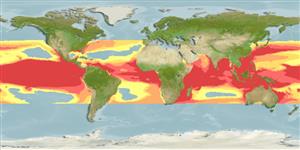Common names from other countries
>
Carangiformes (Jacks) >
Carangidae (Jacks and pompanos) > Caranginae
Etymology: Uraspis: Greek, oura = tail + Greek, aspis = shield (Ref. 45335).
More on author: Poey.
Environment: milieu / climate zone / depth range / distribution range
Ecologia
marino; oceanodromo (Ref. 51243); distribuzione batimetrica 1 - 50 m (Ref. 89972), usually 2 - 15 m (Ref. 40849). Subtropical; 42°N - 34°S, 180°W - 180°E
Worldwide in warm waters. Western Indian Ocean: Tanzania (Ref. 3287, 3197). Eastern Central Pacific: California, USA to Costa Rica (Ref. 2850). Also in Hawaii. Western Atlantic: Massachusetts, USA and northern Gulf of Mexico to Brazil. Eastern Atlantic: Mauritania to Angola (Ref. 7097); also Algoa Bay, South Africa (Ref. 3197).
Size / Peso / Age
Maturity: Lm ? range ? - ? cm
Max length : 50.0 cm TL maschio/sesso non determinato; (Ref. 7251); common length : 40.0 cm TL maschio/sesso non determinato; (Ref. 26999); peso massimo pubblicato: 2.0 kg (Ref. 40637)
Spine dorsali (totale) : 9; Raggi dorsali molli (totale) : 27 - 32; Spine anali: 3; Raggi anali molli: 19 - 23. Adults dark to bluish black; juveniles with 6-7 dark bands with pale interspaces (Ref. 3197).
Adults are mostly oceanic and pelagic but sometimes found near the bottom, often near islands. Solitary or in small schools (Ref. 2850).
Life cycle and mating behavior
Maturities | Riproduzione | Spawnings | Egg(s) | Fecundities | Larve
Smith-Vaniz, W.F., J.-C. Quéro and M. Desoutter, 1990. Carangidae. p. 729-755. In J.C. Quero, J.C. Hureau, C. Karrer, A. Post and L. Saldanha (eds.) Check-list of the fishes of the eastern tropical Atlantic (CLOFETA). JNICT, Lisbon; SEI, Paris; and UNESCO, Paris. Vol. 2. (Ref. 7097)
IUCN Red List Status (Ref. 130435)
CITES (Ref. 128078)
Not Evaluated
Threat to humans
Harmless
Human uses
Pesca: scarso interesse commerciale; Pesce da pesca sportiva: si
Strumenti
Special reports
Download XML
Fonti Internet
Estimates based on models
Preferred temperature (Ref.
115969): 20.9 - 29.1, mean 27.2 (based on 41503 cells).
Phylogenetic diversity index (Ref.
82804): PD
50 = 0.6250 [Uniqueness, from 0.5 = low to 2.0 = high].
Bayesian length-weight: a=0.01349 (0.00646 - 0.02815), b=2.96 (2.79 - 3.13), in cm Total Length, based on LWR estimates for this (Sub)family-body shape (Ref.
93245).
Trophic level (Ref.
69278): 4.0 ±0.5 se; based on size and trophs of closest relatives
Resilienza (Ref.
120179): Medio, tempo minimo di raddoppiamento della popolazione 1.4 - 4.4 anni (Preliminary K or Fecundity.).
Fishing Vulnerability (Ref.
59153): Moderate vulnerability (40 of 100).
